2002 NISSAN ALTIMA ignition
[x] Cancel search: ignitionPage 15 of 249

PRECAUTIONS ON SUPPLE-
MENTAL RESTRAINT SYSTEM
This Supplemental Restraint System (SRS)
section contains important information con-
cerning the driver and passenger front im-
pact supplemental air bags, front seat side-
impact supplemental air bags, curtain air
bags and front seat pre-tensioner seat belts.
Front impact supplemental air bag sys-
tem:This system can help cushion the
impact force to the face and chest of the
driver and front passenger in certain frontal
collisions.
Side-impact supplemental air bag sys-
tem:This system can help cushion the
impact force to the chest area of the driver
and front passenger in certain side impact
collisions. The front seat side-impact
supplemental air bags are designed to in-
flate on the side where the vehicle is im-
pacted.
Side impact supplemental curtain air bag
system:This system can help cushion the
impact force to the head of occupants in
front and rear outboard seating positions in
certain side impact collisions. The curtain
air bags are designed to inflate on the sidewhere the vehicle is impacted.
These supplemental restraint systems are
designed tosupplementthe crash protec-
tion provided by the driver and front passen-
ger seat belts and arenot a substitutefor
them. Seat belts should always be correctly
worn and the occupant seated a suitable
distance away from the steering wheel, in-
strument panel and door finishers. (See
``Seat belts'' later in this section for instruc-
tions and precautions on seat belt usage.)
After turning the ignition key to the ON
position, the supplemental air bag warn-
ing light illuminates. The supplemental
air bag warning light will turn off after
about 7 seconds if the systems are op-
erational.
SUPPLEMENTAL RESTRAINT
SYSTEM
1-8Seats, restraints and supplemental air bag systems
ZX
Page 22 of 249
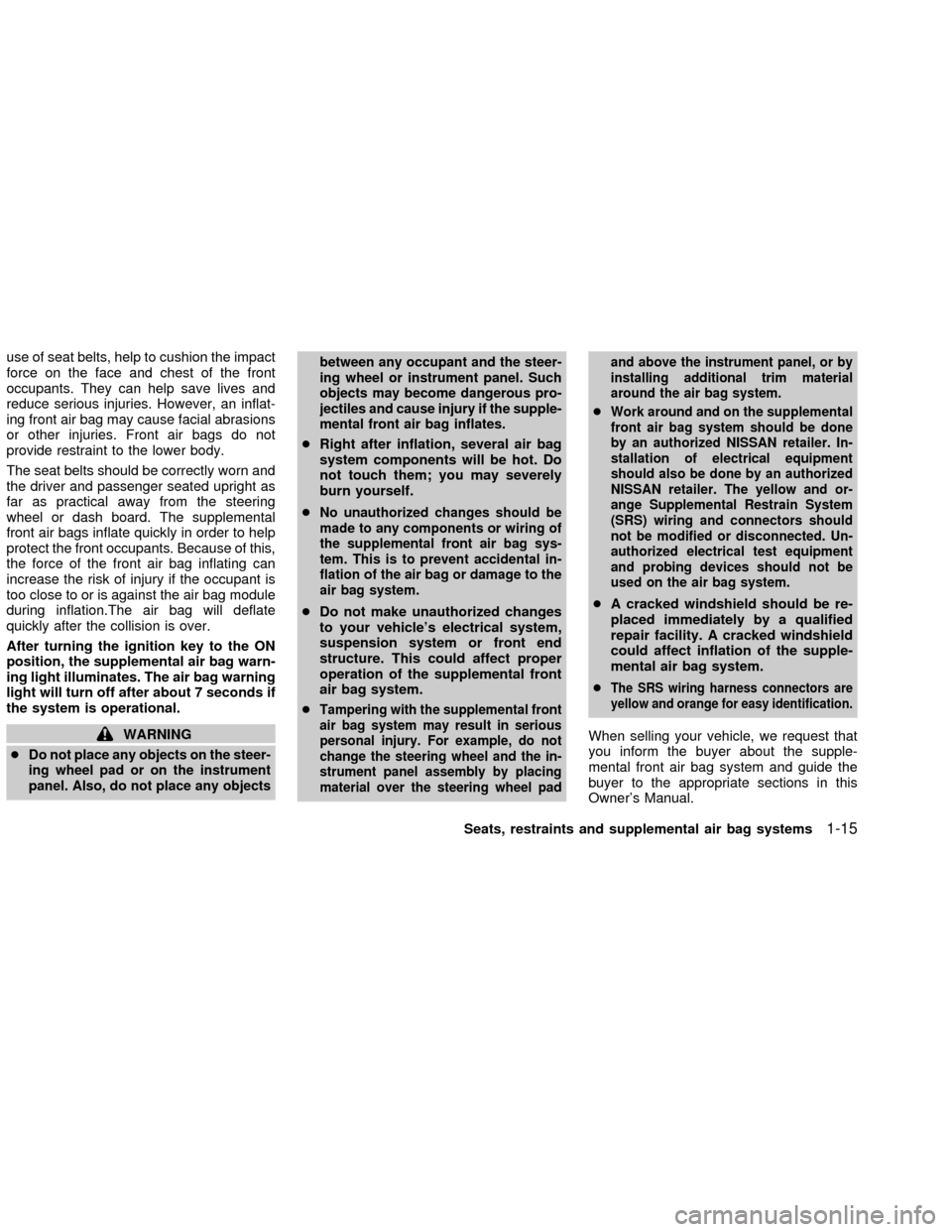
use of seat belts, help to cushion the impact
force on the face and chest of the front
occupants. They can help save lives and
reduce serious injuries. However, an inflat-
ing front air bag may cause facial abrasions
or other injuries. Front air bags do not
provide restraint to the lower body.
The seat belts should be correctly worn and
the driver and passenger seated upright as
far as practical away from the steering
wheel or dash board. The supplemental
front air bags inflate quickly in order to help
protect the front occupants. Because of this,
the force of the front air bag inflating can
increase the risk of injury if the occupant is
too close to or is against the air bag module
during inflation.The air bag will deflate
quickly after the collision is over.
After turning the ignition key to the ON
position, the supplemental air bag warn-
ing light illuminates. The air bag warning
light will turn off after about 7 seconds if
the system is operational.
WARNING
c
Do not place any objects on the steer-
ing wheel pad or on the instrument
panel. Also, do not place any objectsbetween any occupant and the steer-
ing wheel or instrument panel. Such
objects may become dangerous pro-
jectiles and cause injury if the supple-
mental front air bag inflates.
cRight after inflation, several air bag
system components will be hot. Do
not touch them; you may severely
burn yourself.
c
No unauthorized changes should be
made to any components or wiring of
the supplemental front air bag sys-
tem. This is to prevent accidental in-
flation of the air bag or damage to the
air bag system.
cDo not make unauthorized changes
to your vehicle's electrical system,
suspension system or front end
structure. This could affect proper
operation of the supplemental front
air bag system.
c
Tampering with the supplemental front
air bag system may result in serious
personal injury. For example, do not
change the steering wheel and the in-
strument panel assembly by placing
material over the steering wheel padand above the instrument panel, or by
installing additional trim material
around the air bag system.
cWork around and on the supplemental
front air bag system should be done
by an authorized NISSAN retailer. In-
stallation of electrical equipment
should also be done by an authorized
NISSAN retailer. The yellow and or-
ange Supplemental Restrain System
(SRS) wiring and connectors should
not be modified or disconnected. Un-
authorized electrical test equipment
and probing devices should not be
used on the air bag system.
cA cracked windshield should be re-
placed immediately by a qualified
repair facility. A cracked windshield
could affect inflation of the supple-
mental air bag system.
c
The SRS wiring harness connectors are
yellow and orange for easy identification.
When selling your vehicle, we request that
you inform the buyer about the supple-
mental front air bag system and guide the
buyer to the appropriate sections in this
Owner's Manual.
Seats, restraints and supplemental air bag systems
1-15
ZX
Page 23 of 249
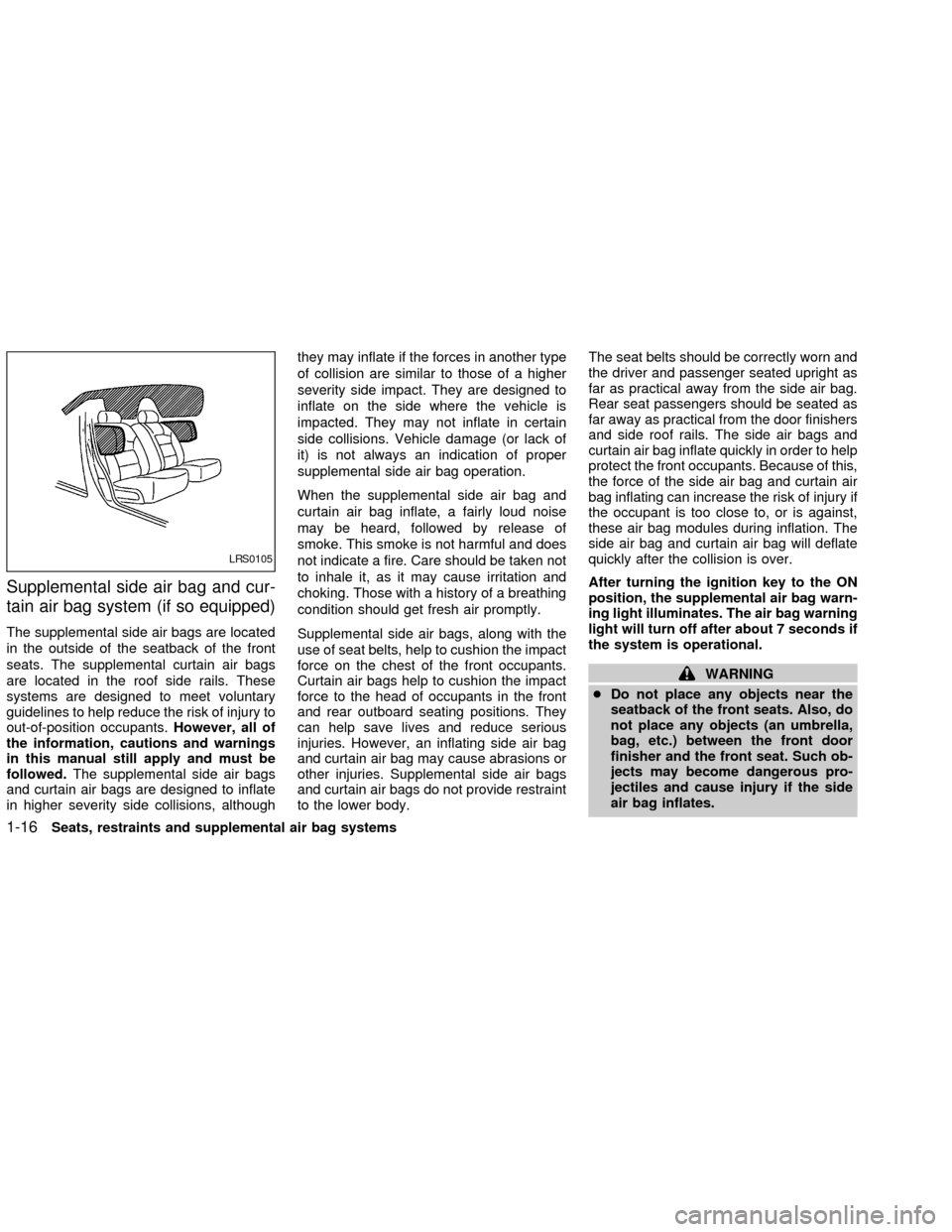
Supplemental side air bag and cur-
tain air bag system (if so equipped)
The supplemental side air bags are located
in the outside of the seatback of the front
seats. The supplemental curtain air bags
are located in the roof side rails. These
systems are designed to meet voluntary
guidelines to help reduce the risk of injury to
out-of-position occupants.However, all of
the information, cautions and warnings
in this manual still apply and must be
followed.The supplemental side air bags
and curtain air bags are designed to inflate
in higher severity side collisions, althoughthey may inflate if the forces in another type
of collision are similar to those of a higher
severity side impact. They are designed to
inflate on the side where the vehicle is
impacted. They may not inflate in certain
side collisions. Vehicle damage (or lack of
it) is not always an indication of proper
supplemental side air bag operation.
When the supplemental side air bag and
curtain air bag inflate, a fairly loud noise
may be heard, followed by release of
smoke. This smoke is not harmful and does
not indicate a fire. Care should be taken not
to inhale it, as it may cause irritation and
choking. Those with a history of a breathing
condition should get fresh air promptly.
Supplemental side air bags, along with the
use of seat belts, help to cushion the impact
force on the chest of the front occupants.
Curtain air bags help to cushion the impact
force to the head of occupants in the front
and rear outboard seating positions. They
can help save lives and reduce serious
injuries. However, an inflating side air bag
and curtain air bag may cause abrasions or
other injuries. Supplemental side air bags
and curtain air bags do not provide restraint
to the lower body.The seat belts should be correctly worn and
the driver and passenger seated upright as
far as practical away from the side air bag.
Rear seat passengers should be seated as
far away as practical from the door finishers
and side roof rails. The side air bags and
curtain air bag inflate quickly in order to help
protect the front occupants. Because of this,
the force of the side air bag and curtain air
bag inflating can increase the risk of injury if
the occupant is too close to, or is against,
these air bag modules during inflation. The
side air bag and curtain air bag will deflate
quickly after the collision is over.
After turning the ignition key to the ON
position, the supplemental air bag warn-
ing light illuminates. The air bag warning
light will turn off after about 7 seconds if
the system is operational.
WARNING
cDo not place any objects near the
seatback of the front seats. Also, do
not place any objects (an umbrella,
bag, etc.) between the front door
finisher and the front seat. Such ob-
jects may become dangerous pro-
jectiles and cause injury if the side
air bag inflates.
LRS0105
1-16Seats, restraints and supplemental air bag systems
ZX
Page 25 of 249
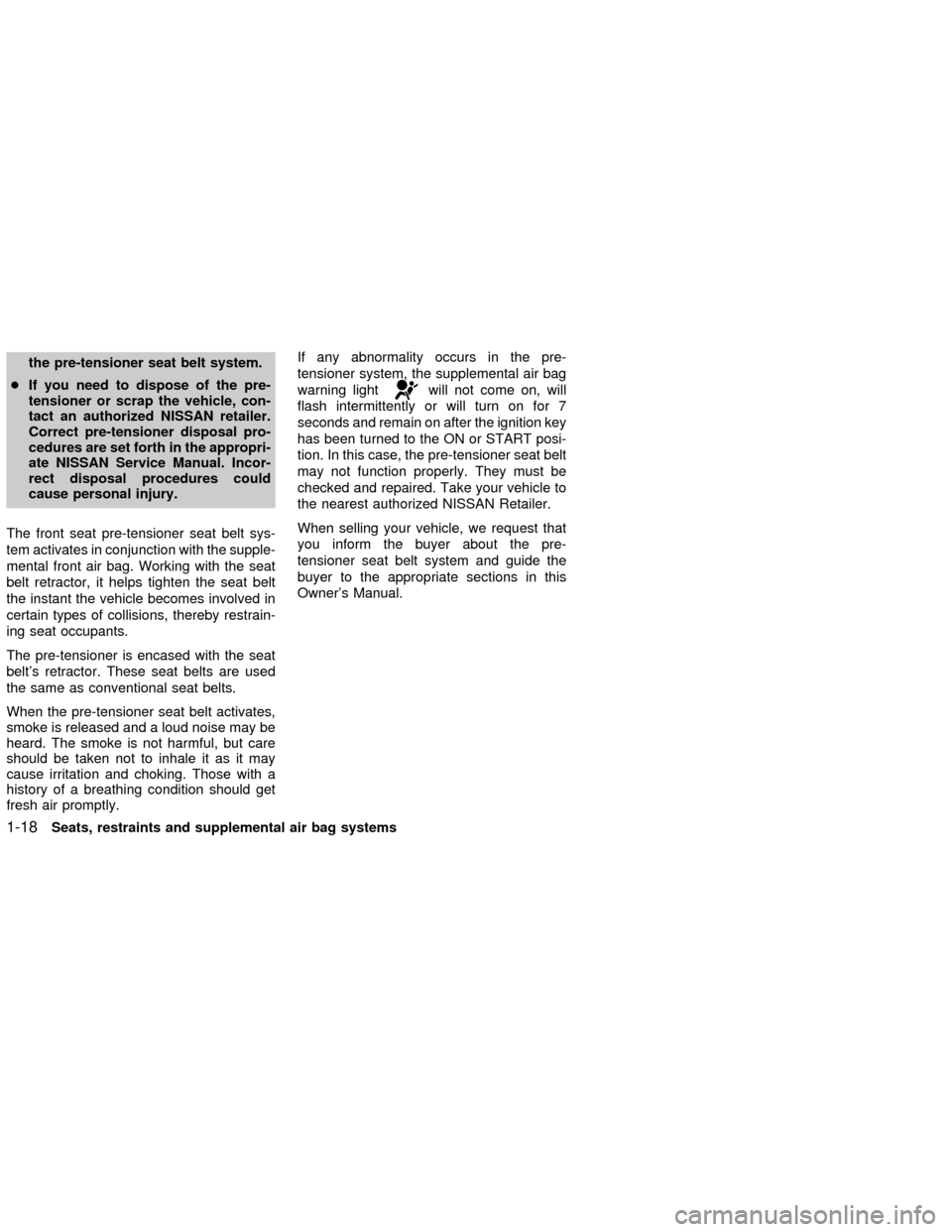
the pre-tensioner seat belt system.
cIf you need to dispose of the pre-
tensioner or scrap the vehicle, con-
tact an authorized NISSAN retailer.
Correct pre-tensioner disposal pro-
cedures are set forth in the appropri-
ate NISSAN Service Manual. Incor-
rect disposal procedures could
cause personal injury.
The front seat pre-tensioner seat belt sys-
tem activates in conjunction with the supple-
mental front air bag. Working with the seat
belt retractor, it helps tighten the seat belt
the instant the vehicle becomes involved in
certain types of collisions, thereby restrain-
ing seat occupants.
The pre-tensioner is encased with the seat
belt's retractor. These seat belts are used
the same as conventional seat belts.
When the pre-tensioner seat belt activates,
smoke is released and a loud noise may be
heard. The smoke is not harmful, but care
should be taken not to inhale it as it may
cause irritation and choking. Those with a
history of a breathing condition should get
fresh air promptly.If any abnormality occurs in the pre-
tensioner system, the supplemental air bag
warning light
will not come on, will
flash intermittently or will turn on for 7
seconds and remain on after the ignition key
has been turned to the ON or START posi-
tion. In this case, the pre-tensioner seat belt
may not function properly. They must be
checked and repaired. Take your vehicle to
the nearest authorized NISSAN Retailer.
When selling your vehicle, we request that
you inform the buyer about the pre-
tensioner seat belt system and guide the
buyer to the appropriate sections in this
Owner's Manual.
1-18Seats, restraints and supplemental air bag systems
ZX
Page 27 of 249
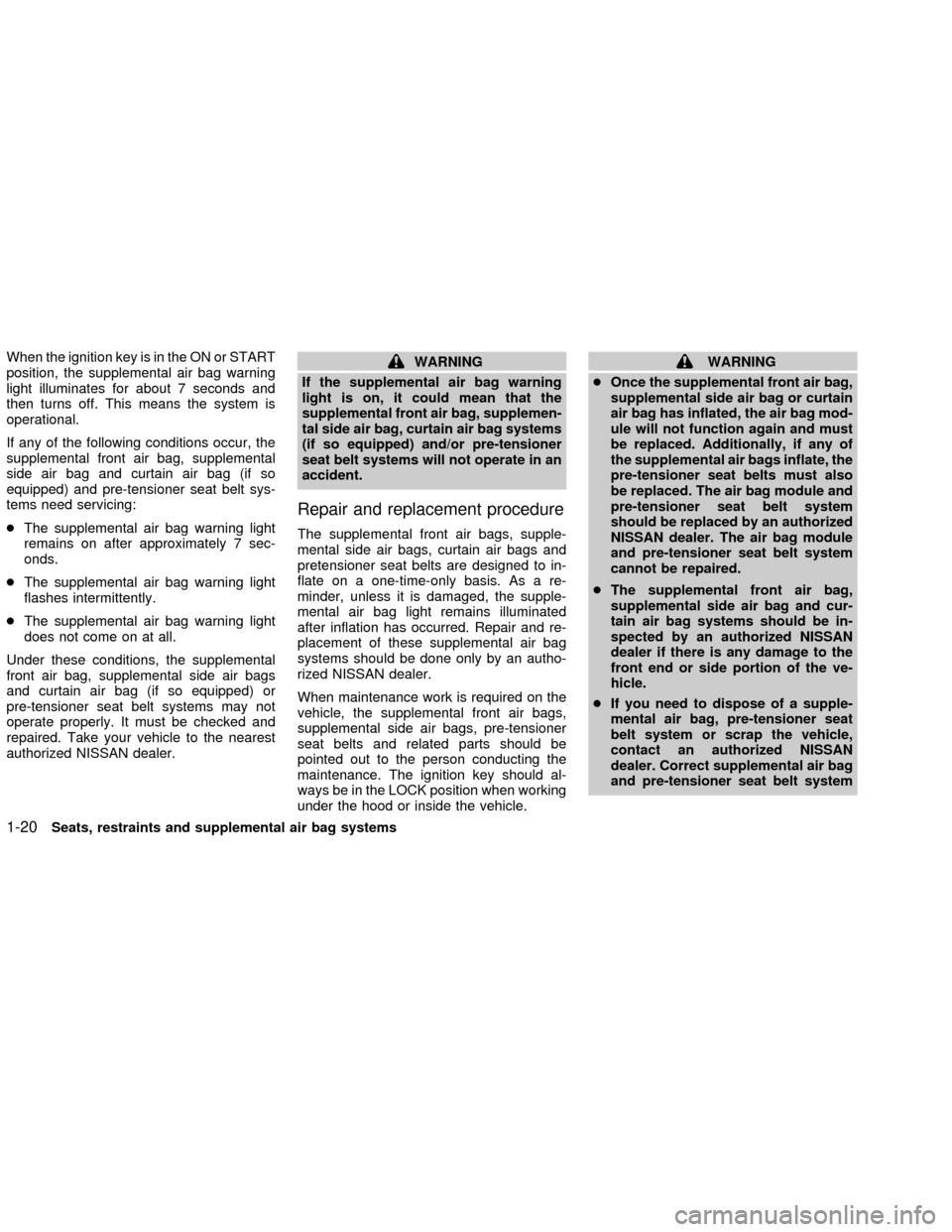
When the ignition key is in the ON or START
position, the supplemental air bag warning
light illuminates for about 7 seconds and
then turns off. This means the system is
operational.
If any of the following conditions occur, the
supplemental front air bag, supplemental
side air bag and curtain air bag (if so
equipped) and pre-tensioner seat belt sys-
tems need servicing:
cThe supplemental air bag warning light
remains on after approximately 7 sec-
onds.
cThe supplemental air bag warning light
flashes intermittently.
cThe supplemental air bag warning light
does not come on at all.
Under these conditions, the supplemental
front air bag, supplemental side air bags
and curtain air bag (if so equipped) or
pre-tensioner seat belt systems may not
operate properly. It must be checked and
repaired. Take your vehicle to the nearest
authorized NISSAN dealer.WARNING
If the supplemental air bag warning
light is on, it could mean that the
supplemental front air bag, supplemen-
tal side air bag, curtain air bag systems
(if so equipped) and/or pre-tensioner
seat belt systems will not operate in an
accident.
Repair and replacement procedure
The supplemental front air bags, supple-
mental side air bags, curtain air bags and
pretensioner seat belts are designed to in-
flate on a one-time-only basis. As a re-
minder, unless it is damaged, the supple-
mental air bag light remains illuminated
after inflation has occurred. Repair and re-
placement of these supplemental air bag
systems should be done only by an autho-
rized NISSAN dealer.
When maintenance work is required on the
vehicle, the supplemental front air bags,
supplemental side air bags, pre-tensioner
seat belts and related parts should be
pointed out to the person conducting the
maintenance. The ignition key should al-
ways be in the LOCK position when working
under the hood or inside the vehicle.
WARNING
cOnce the supplemental front air bag,
supplemental side air bag or curtain
air bag has inflated, the air bag mod-
ule will not function again and must
be replaced. Additionally, if any of
the supplemental air bags inflate, the
pre-tensioner seat belts must also
be replaced. The air bag module and
pre-tensioner seat belt system
should be replaced by an authorized
NISSAN dealer. The air bag module
and pre-tensioner seat belt system
cannot be repaired.
cThe supplemental front air bag,
supplemental side air bag and cur-
tain air bag systems should be in-
spected by an authorized NISSAN
dealer if there is any damage to the
front end or side portion of the ve-
hicle.
cIf you need to dispose of a supple-
mental air bag, pre-tensioner seat
belt system or scrap the vehicle,
contact an authorized NISSAN
dealer. Correct supplemental air bag
and pre-tensioner seat belt system
1-20Seats, restraints and supplemental air bag systems
ZX
Page 53 of 249

in the speedometer display. When the igni-
tion is turned to ON, the display scrolls all
the modes of the trip computer and then
shows the mode chosen before the ignition
switch is turned OFF.
If the battery terminal is disconnected,
push the trip computer mode switch
more than 1 second to activate the com-
puter.
When the ignition switch is turned to ON,
modes of the trip computer can be selected
by pushing the trip mode switch on the
steering wheel switch for audio controls or
by the trip computer change button. The
following modes can be selected:
Outside air temperature (ICY±ÉF or
ÉC)
The outside air temperature is displayed in
ÉF or ÉC.
The outside air temperature mode includes
a low temperature warning feature: below
37ÉF (3ÉC), the outside air temperaturemode is automatically selected and ICY will
illuminate in order to draw the driver's atten-
tion. Press the mode switch if you wish to
return to the mode that was selected before
the warning occurred. The ICY indicator will
continue blinking as long as the tempera-
ture remains below 39ÉF (4ÉC).
The ambient temperature sensor is located
in front of the radiator. The sensor may be
affected by road or engine heat, wind direc-
tions and other driving conditions. The dis-
play may differ from the actual ambient
temperature or the temperature displayed
on various signs or billboards.
Distance to empty (dte±mile or km)
The distance to empty (dte) mode provides
you with an estimation of the distance that
can be driven before refueling. The dte is
constantly being calculated, based on the
amount of fuel in the fuel tank and the actual
fuel consumption.
The display is updated every 30 seconds.
The dte mode inlcudes a low range warning
feature: when the fuel level is low, the dte
mode is automatically selected and the dig-
its blink in order to draw the driver's atten-
tion. Press the mode switch if you wish to
WIC0159
2-4Instruments and controls
ZX
Page 54 of 249

return to the mode that was selected before
the warning occurred. The dte mark (dte)
will remain blinking until the vehicle is refu-
elled.
When the fuel level drops even lower, the
dte display will change to (----).
NOTE:
cIf the amount of fuel added while the
ignition switch is OFF is small, the
display just before the ignition switch
is turned OFF may continue to be
displayed.
cWhen driving uphill or rounding
curves, the fuel in the tank shifts,
which may momentairly change the
display.
Average fuel consumption
(Mpg or l/100km)
The Average fuel consumption mode shows
the average fuel consumption since the last
reset. Resetting is done by pressing the
mode switch for more than approximately 1
second. The display is updated every 30
seconds. At about the first 1/3 miles (500 m)
after a reset, the display shows (----).
Average speed (MPH or km/h)
The average speed mode shows the aver-
age vehicle speed since last reset. Reset-
ting is done by pressing the mode switch for
more than approximately 1 minute. The
display is updated every 30 seconds. The
first 30 seconds after a reset, the display
shows (----).
Journey time
The journey time mode shows the time
since the last reset. The displayed time can
be reset by pressing the mode switch for
more than approximately 1 second.
NOTE:
If a low temperature warning and low
range warning occur simultaneously,
other display modes switch automati-
cally to the outside temperature display.
When the mode switch is pushed, the
display switches to the mode chosen
before the warning display, and the out-
side air temperature indicator marked
ICY will blink.
WIC0187
Instruments and controls2-5
ZX
Page 56 of 249
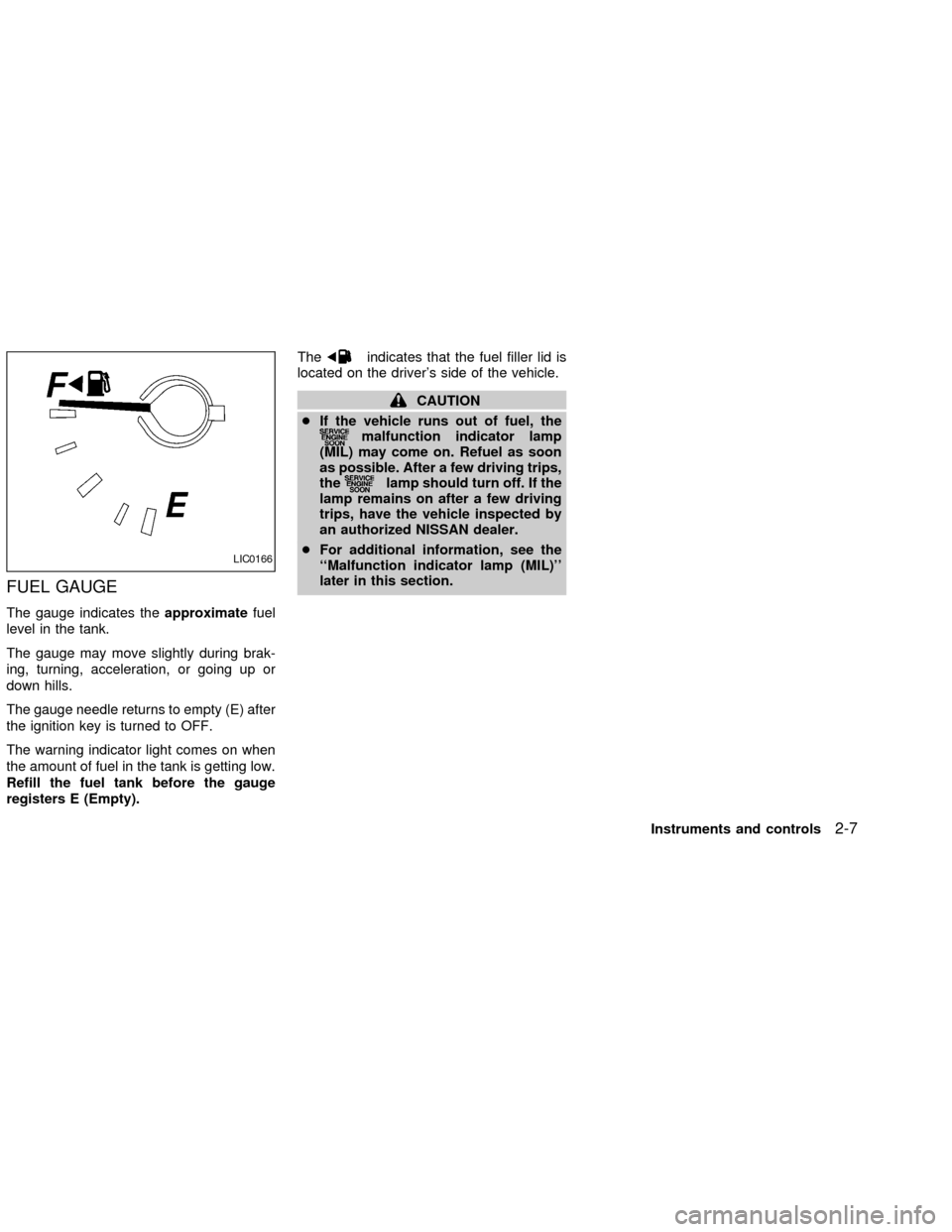
FUEL GAUGE
The gauge indicates theapproximatefuel
level in the tank.
The gauge may move slightly during brak-
ing, turning, acceleration, or going up or
down hills.
The gauge needle returns to empty (E) after
the ignition key is turned to OFF.
The warning indicator light comes on when
the amount of fuel in the tank is getting low.
Refill the fuel tank before the gauge
registers E (Empty).The
indicates that the fuel filler lid is
located on the driver's side of the vehicle.
CAUTION
cIf the vehicle runs out of fuel, the
malfunction indicator lamp
(MIL) may come on. Refuel as soon
as possible. After a few driving trips,
the
lamp should turn off. If the
lamp remains on after a few driving
trips, have the vehicle inspected by
an authorized NISSAN dealer.
cFor additional information, see the
``Malfunction indicator lamp (MIL)''
later in this section.
LIC0166
Instruments and controls2-7
ZX